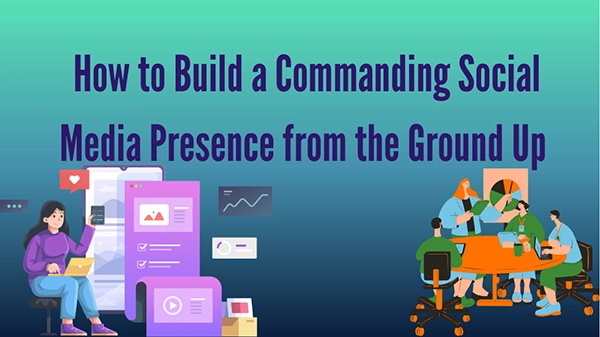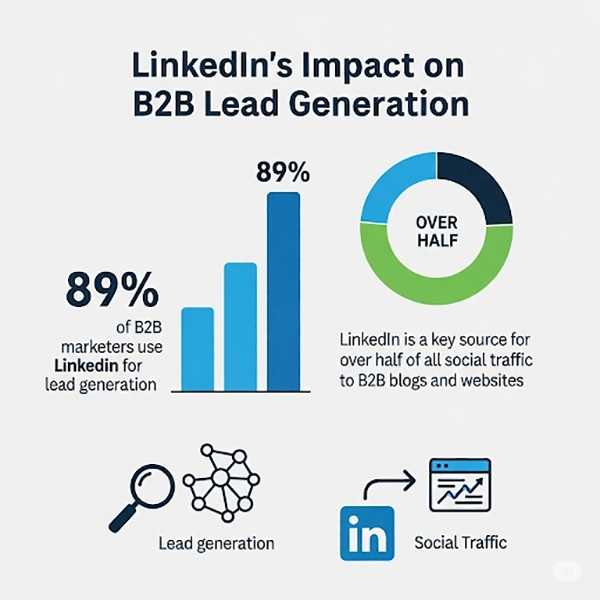How to Build a Commanding Social Media Presence from the Ground Up

In today’s digital-first world, not having a social media presence is like having a storefront with no sign. It is a missed opportunity to connect, engage, and grow. But for many businesses, the idea of starting from zero feels overwhelming.
A recent study by Statista says that approximately 4.9 billion people worldwide were active social media users in 2023, a number projected to grow to nearly 6 billion by 2027.
For many businesses, the idea of starting from zero feels overwhelming. With so many platforms and strategies, where do you even begin? The key isn’t to be everywhere at once; it is to be in the right places, with the right message, consistently. Let us break down how to build that presence, step by step.
KEY TAKEAWAYS
- Don’t start posting without a plan. Define your specific goals and target audience first to ensure your social media efforts align with your business objectives.
- Create a content strategy with “pillars”—core topics you’ll consistently address. Follow the 80/20 rule and mix up content formats to keep your audience engaged.
- Social media is about conversation, not just broadcasting. Actively respond to comments, engage with other accounts in your niche, and foster a sense of community to build trust and loyalty.
- Use analytics to track meaningful metrics, not just follower count. Learn from your data to refine your strategy and improve performance over time.
- Building a commanding social media presence is a marathon, not a sprint. Be patient and consistent, as it can take 6–12 months to see significant results.
Laying the Foundation: Strategy Before Tactics
The first step is to respond to a fundamental question: Why are you on social media? Your target market will dictate your entire approach. Are you trying to drive traffic to your website, build brand awareness, generate leads, or create a community of loyal customers? Be particular.
As opposed to “get more sales,” strive to “increase website conversions from Instagram by 15% this quarter.” Next, define your target audience.
Go beyond fundamental demographics. What are their pain points, interests, and online habits? It is much more beneficial to know that you are aiming for “30-year-old project managers who love productivity hacks” rather than just “millennials.” This knowledge will directly inform which platforms you choose.
A B2B tech firm will likely find more success on LinkedIn, while a fashion brand will perform better on Instagram and Pinterest. Prior to growing, become an expert on one or two pertinent platforms.
Once you have a clear grasp of your objectives and target audience, it’s time to organize what you will share. The approach of posting random updates won’t build a loyal following. You should develop a content strategy that consistently provides value.
Crafting a Content Strategy That Resonates
Imagine your content in terms of “pillars”—three to five core topics your brand will consistently talk about. For a fitness coach, these might be healthy recipes, workout tips, and motivational stories. This ensures your content remains focused and relevant to your audience.
The 80/20 principle is a great guideline: only 20% of your content should be directly promotional, with the remaining 80% of your content being useful, instructive, or entertaining for your audience.
Accounts are followed for the value they provide, not to be sold to constantly. To keep things interesting, mix up your formats by using a mix of informative carousels, captivating stories, short-form videos (such as Reels or Shorts), and high-quality photos.
Consistency in your visual style and brand voice is also essential for building a recognizable and memorable presence on social media.
Posting great content is only half the equation. The capacity of social media to promote interaction and connection is where its true power resides. If you’re just broadcasting messages while not listening, you’re missing the point entirely.
INTERESTING FACT
89% of B2B marketers use LinkedIn for lead generation, and it’s a key source for over half of all social traffic to B2B blogs and websites.

The Art of Engagement and Community Building
Social media is a two-way street. Respond to people thoroughly when they take the time to comment on your post. Answer their queries and acknowledge their feedback. This small gesture demonstrates your attention and gives your followers a sense of importance, but don’t wait for them to approach you.
Proactively engage with other accounts in your comment on relevant posts, niche, and participate in industry conversations. This boosts your visibility and establishes you as an active member of the community. For brands just starting, gaining that preliminary traction can be the hardest part.
So, you’re posting on a daily basis and engaging with your audience. But how do you know if your efforts are paying off? This is where data enters the picture. Ignoring the situation will only lead to stagnation.
Measuring What Matters: Analytics and Iteration
Every leading social media site offers a free suite of analytics tools. It is simple to become engrossed in “vanity metrics” such as the number of followers, but these don’t provide a complete picture. Instead, focus on metrics that go along with your goals. If your objective is brand awareness, look at reach and impressions.
If it’s engagement, track your comments, shares, likes, and saves to calculate your engagement rate. On the other hand, if your goal is driving traffic, monitor your click-through rate.
To find out what is and is not working, review your analytics once a week or once a month. Did a certain kind of video received a lot of shares? Make more of it. Did a post at a particular time perform poorly? Adjust your schedule.
This might all seem like a full-time job, and for many, it is. Fortunately, there are many tools available to help you manage your presence more effectively without compromising quality.
Ans: There’s not a one magic number, as it varies by platform and audience. Three to five times a week on Facebook and Instagram and one to three times a day on X (formerly Twitter) are excellent places to start. The most significant thing is consistency. Instead of posting twice a day for a week and then going silent for a month, it is preferable to publish three excellent posts every week.
Ans: A high engagement rate is far more valuable for most businesses. As opposed to a large, passive audience that never likes or comments, a smaller, highly engaged audience that interacts with your content and trusts your brand is more likely to become customers. If you concentrate on building a community, and the right kind of followers will come.
Ans: Even though content can be reused, you shouldn’t just copy and paste the same post everywhere. Each platform has a unique audience and format. Given Instagram’s emphasis on visuals, a lengthy, text-heavy post that performs well on LinkedIn is probably going to fall flat. Customize your message and format to adjust the context of each platform for the best results.
Ans: Building a successful social media presence is a marathon, not a sprint. Even though you might experience some early successes, it usually takes six to twelve months of persistent work to see meaningful, quantifiable outcomes that affect your company’s objectives. Patience and persistence are key.
